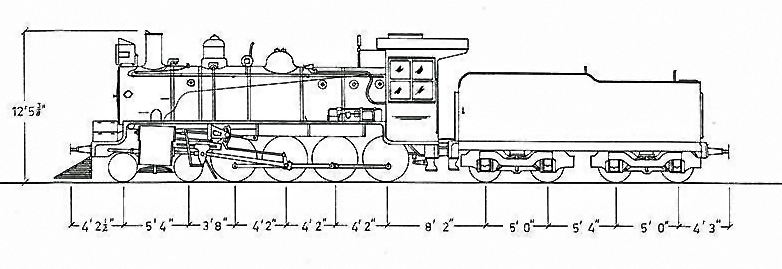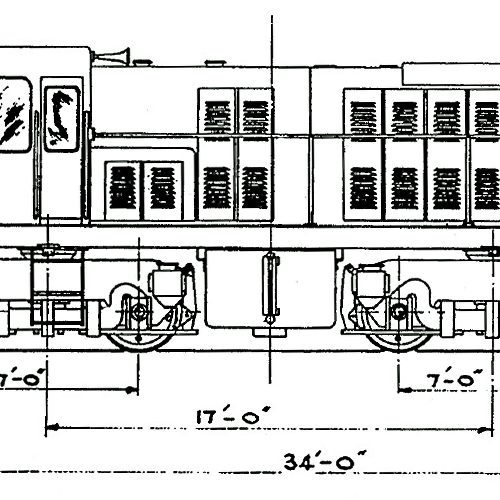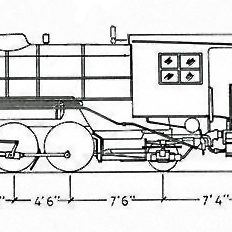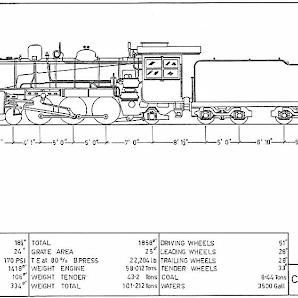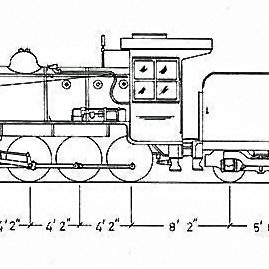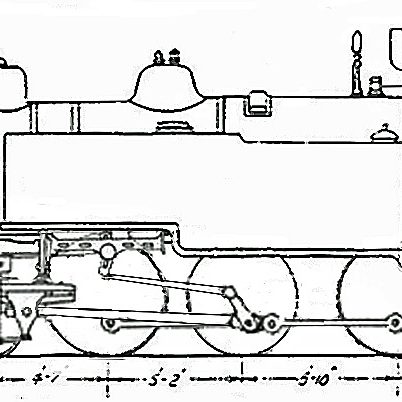These versatile engines were a superheated version of the earlier built C16s. The class eventually contained more engines and was built over a longer period than any other type on QR. Five builders constructed 227 engines between 1920 and 1953. Commonwealth Railways used this design for their NM Class.
The first engine, N°15 was built by Ipswich Workshops and entered service on 12th August 1920. This low road number was due to a policy in force at the time to reuse numbers off recently condemned locomotives. Increasing traffic and the completion of the North Coast Railway linking Brisbane with Cairns in 1924 created a demand for additional motive power. To meet this shortage, 143 C17 Class locomotives were constructed by 1929. Such was the urgency for new motive power, that the government of the day awarded one contract to a UK firm for 20 locomotives, contrary to its policy that supported local manufacturers. Onset of the Great Depression and consequent reduced loading then subdued the need for any additional motive power. Indeed, many of the existing engines were placed in storage. As the economy slowly recovered, Ipswich produced a further six locomotives in 1938. These incorporated a number of new features similar to those introduced on the most recently completed batch of B18¼ engines. Increased traffic during World War 2 saw the Commissioner for Railways seek to obtain a further 60 members of the class. Wartime exigencies prevented this being achieved and ultimately resulted in the importation of 20 AC16 Class engines from America and delivery of 23 of the ill-fated Australian Standard Garratts that had been developed under auspices of the Commonwealth Land Transport Board. Unfortunately, neither of these acquisitions had the availability or versatility of the C17 Class. Walkers Limited delivered the next six C17s in 1945 and post war orders were placed for a further 66. The last engine of the class, N°1000, entered service on 21st September 1953.
The engines built up until 1929 had large steam domes, open cabs and C16 style tenders. Those constructed from 1938 onwards, commencing with N°858, had small steam domes, sedan cabs with welded tenders and also larger diameter (9½”) piston valves. The two types of boilers were occasionally interchanged at overhauls and by later years most of the old-style ones had been replaced. The last 40 engines, N°961 to N°1000, were fitted with roller bearings and painted brown with green lining. They acquired the nick name of “Brown Bombers” after world champion boxer Joe Lewis. Those overhauled in the last years of steam operations were repainted black. The fitting of large mushroom air snifting valves above the cylinders was possibly the most obvious of numerous modifications that were carried out to most members of the class during their long working lives. Several also had additional sandboxes and/or rear headlights fitted at various times for working branch lines where no turning facilities were available.
They were used to haul Mail Trains on lines could not accommodate heavier (B18¼) classes, also suburban passenger, mixed, goods and branch line trains. Until 1948 they were the heaviest engines that could work north of Mackay. Prior to the introduction of 60ton Diesel Electric Locomotives, they were responsible for hauling the air-conditioned Inlander, Midlander and Westlander air-conditioned trains for parts of their respective journeys. The engines had wide availability and by 1960 were still the heaviest locomotives that could operate on 85% of the system. Despite being designed to run on 41¼ and 42lb rails they were regularly used on the heavier main lines. Here, they acquitted themselves well with goods and passenger trains at moderate speeds. They were capable of hauling approximately 90% of a B18¼ loads on goods trains but owing to their limited boiler capacity this figure was considerably less on passenger trains that ran to tight schedules on sections with long uphill grades. Due to their short travel valves, they were hard pressed to attain speeds much above 45mph. Until 1967, they were rostered to work the South Western Mail between Warwick and Dirranbandi. This involved a single engine working a return trip of 513miles (826km) in a little over 24 hours.
The class was considered to be reliable by the administration and was generally popular with their crews although they could be uncomfortable to ride on at higher speeds. The first engine was written off in 1952 after 31 years’ service. Over 200 members of the class were still on the register in 1960. Strengthening of some lines and increasing numbers of diesels saw them gradually relegated to less important roles although it was not unusual for Ipswich to use one to substitute for an unavailable B18¼ or BB18¼ on Brisbane suburban passenger trains as late as 1967. After the commencement of Moura coal traffic and before the rearrangement of Gladstone yard, C17 engines were used to haul coal trains from the yard to the unloading facilities at the wharf. This involved moving loads in excess of 1000 tons. Engines used for this work were the only QR steam locomotives to be fitted with two-way radios. Nineteen were still in service in November 1969; ten at Ipswich, eight at Mackay and one at Maryborough. The last 34 members of the class were written off the books in 1970 although several of them continued to be used around Ipswich for shunting and departmental purposes until March 1972.
An ‘improved C17’, with a 2-8-2-wheel arrangement, was designed after World War 2 incorporating features of both the existing C17 and AC16 engines. Approval was granted for eighteen of these new CC17 engines to be built at Ipswich Workshops. Construction began in 1950 but at a retarded rate because of post war material shortages and the heavy repair programme. With increasing interest now centred on diesel traction the venture gradually lost its priority. Some components were built but no major assembly work was completed and by 1953 the project was abandoned.
| Builder | N° Built | Construction Period |
| Ipswich Railway Workshops | 16 | 1920-22, 1938 |
| Walkers Limited, Engineers, Maryborough, Qld | 138 | 1920-23, 1927, 1929, 1945-46, 1948, 1950-53 |
| Evans, Anderson, Phelan & Co, Brisbane | 28 | 1921-23, 1925-27 |
| Sir W G Armstrong Whitworth & Co, UK | 25 | 1927 |
| Clyde Engineering Co, Granville, NSW | 20 | 1948-50 |
| TOTAL | 227 | 1920 – 1953 |
Locomotives
-
Wheel arrangement
4-8-0
-
Cylinders (diameter X stroke) ins. (4)
17 X 22
-
Rigid Wheel Base
12’6”
-
Length over Buffers
53’5½”
-
Coupled Wheels diameter ins.
45
-
Axle Load
8.3 original | 9.2 from 1935 modification | 8.7 from 1938 design | 8.9 Roller Bearing
-
Boiler Pressure psi
160 original | 1.75 from 1935 modification |
-
Heating Surface of tubes - sq feet
823 original | 733 from 1935 modification | 733 from 1938 design | 763 Roller Bearing
-
Heating Surface total - sq feet
1000 original | 951 from 1935 modification | 951 from 1938 design | 909 Roller Bearing
-
Grate area - sq feet
18.5
-
Weight - adhesive - tons
33.1 original | 35.5 Roller Bearing
-
Weight Engine
44.9 original | 48 Roller Bearing
-
Coal capacity - tons
4.5 original | 8 from 1935 modification | 7.35 from 1938 design
-
Tractive Effort - lbs. (85%)
19215 original | 21016 from 1935 modification
-
Factor of Adhesion
3.86 original | 3.53 from 1935 modification | 3.53 from 1938 design | 3.79 Roller Bearing
-
Valve Gear
Walschaert
-
WH Pump
10 X 10⅝
-
Brake Valve
No 4 original | No 4 from 1935 modification | A6-ET from 1938 design | A6-ET Roller Bearing
